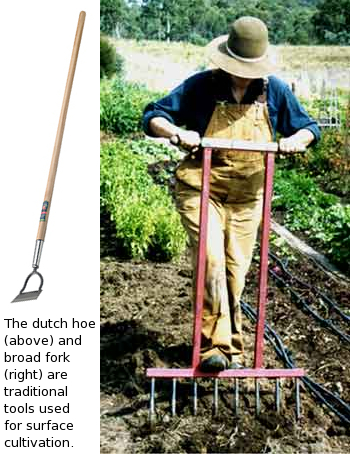
Surface cultivation as a no-till technique
 I've already written a long post about sheet mulching, one good method of growing
plants without tilling the soil. The problem with sheet mulching
is that it requires gobs of organic matter. Can you get similar
results with less outlay of cash?
I've already written a long post about sheet mulching, one good method of growing
plants without tilling the soil. The problem with sheet mulching
is that it requires gobs of organic matter. Can you get similar
results with less outlay of cash?
A traditional British
method of gardening without tilling is known as surface
cultivation. Farmers usually till or dig the soil the first year
to loosen the ground and increase soil pores, but after this they
merely layer two to four inches of compost onto the ground each year
and plant without tilling. A special hoe known as a Dutch hoe
cuts off weeds just below the crown, leaving the roots in place to
increase fertility of the soil and leaving the tops in place to mulch
the soil surface. By the third year of surface cultivation, very
few weeds are left since new seeds aren't turned up through tilling.
My gardening technique
has aspects of surface cultivation in it, and I'm looking forward to
that decline in weeding (two years from now since my 2008 garden went
to seed and set me back a couple of years.) Robert Kourik notes
that the tedious weeding in surface cultivation can be minimized by
mulching as much as possible. My father has good luck laying damp
newspapers around his vegetables, a method that I may have to try next
year. This year's grass
clipping mulch has
also been highly effective.
The problem with surface
cultivation, beyond labor-intensive weeding, is that productivity often
begins to decline after 5 to 6 years when soil compacts. Some
farmers simply till their garden at that point and begin again.
Others use a spading fork or broad fork to loosen the soil without
tilling. I suspect that simple crop rotation may do the trick in
our garden --- we grow enough root crops that require the ground to be
churned up during harvest that we will probably end up digging every
bed at least once or twice a decade.
This post is part of our lunchtime series reviewing Robert Kourik's Designing and Maintaining your
Edible Landscape Naturally.
Read all of the entries:
|
Want more in-depth information? Browse through our books.
Or explore more posts by date or by subject.
About us: Anna Hess and Mark Hamilton spent over a decade living self-sufficiently in the mountains of Virginia before moving north to start over from scratch in the foothills of Ohio. They've experimented with permaculture, no-till gardening, trailersteading, home-based microbusinesses and much more, writing about their adventures in both blogs and books.
Want to be notified when new comments are posted on this page? Click on the RSS button after you add a comment to subscribe to the comment feed, or simply check the box beside "email replies to me" while writing your comment.
